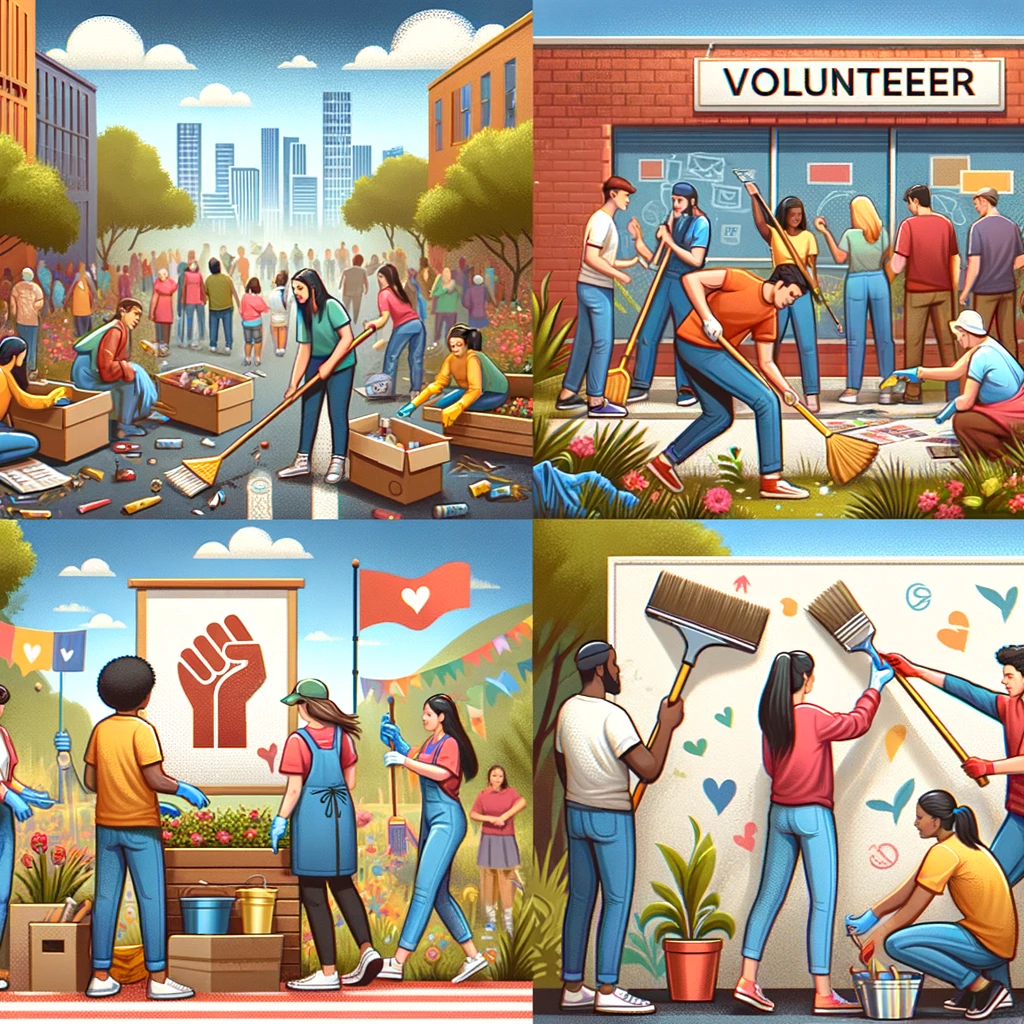Local community resources in Connecticut (CT) encompass a wide range of services and facilities aimed at supporting and enhancing the well-being of its residents. These local resources can vary depending on the specific area within Connecticut, but typically include: (Note: These local resources may not be identical to your home, please check.)
Local Community Resources: Educational Resources

Public libraries, community colleges, adult education centers, and after-school programs offer educational opportunities for all ages.
- Free Community College: Eligible first-time, full-time college students who graduated from a Connecticut high school (including GED or home-schooled students) may qualify for free community college.
- Income-Driven Student Loan Repayment Plan: This plan, part of the Saving on a Valuable Education (SAVE) initiative, calculates payments based on income and family size, with loan forgiveness after a set period.
- Public Service Loan Forgiveness (PSLF) Program: This program is designed to forgive the remaining balance on Direct Loans after 120 qualifying monthly payments under a qualifying repayment plan while working full-time for a qualifying employer.
- Adult Education Resources: Various resources are available for adult education in Connecticut
Local Community Resources: Healthcare Services

Community health centers, clinics, hospitals, mental health services, and substance abuse treatment facilities provide essential healthcare.
- Access Health CT: Connecticut’s official health insurance marketplace offering various health and dental plans, with financial aid options available.
- Discount Prescription Cards: Available for all Connecticut residents to save on prescription medications.
- Free COVID-19 Tests and Treatments: Available through federal initiatives for eligible individuals.
- HUSKY Health Coverage: Expanded to include non-citizen children and offers renewals of health insurance coverage.
- SNAP (Supplemental Nutrition Assistance Program): Assistance to help pay for food through a debit-type card.
- WIC (Special Supplemental Nutrition Program for Women, Infants, and Children): Provides advice from nutritionists and an EBT card for eligible individuals.
- USDA Nutrition Materials: Offers resources for healthy eating and meal prepping.
- Crisis Services: Includes the ACTION line for adults in distress and crisis services for youth.
- Adult Mobile Crisis Services: Provides immediate assistance and various support services for adults in mental health or substance use crises.
- Crisis Intervention Team (CIT): A partnership between law enforcement and mental health services to provide crisis intervention and referrals.
- 988 Suicide & Crisis Lifeline: Offers 24/7 access to trained crisis contact center staff for people experiencing suicidal, substance use, and other mental health crises.
Local Community Resources: Social Services

Agencies offering assistance with food, housing, unemployment, and other social needs are available. This includes food banks, shelters, and government assistance programs.
- Housing Choice Voucher Program: Offers assistance for eligible individuals and families to find affordable housing.
- Eviction Prevention Program: Provides rental assistance to qualifying tenants facing eviction.
- Emergency Mortgage Assistance Program: Long-term help for homeowners struggling with mortgage payments.
- Weatherization Assistance Program: Helps reduce energy-related costs through home improvements.
Local Community Resources: Recreational Facilities

Public parks, community centers, sports facilities, and recreational programs for various age groups.
activities. These facilities include state parks and forests, as well as specialized camping areas, providing a range of options for outdoor enthusiasts:
- State Parks and Forests: Connecticut is home to 110 state parks and 32 forests, offering a wide range of recreational activities, including camping, fishing, swimming, and hiking. These areas are managed by the Department of Energy and Environmental Protection and provide opportunities for outdoor enjoyment and exploration.
- Camping Facilities in State Parks and Forests:
- Black Rock State Park: Located in Watertown, this park offers 78 wooded and open sites for camping, with amenities like a dumping station, bathrooms, showers, fishing, and swimming. The campground is open from May 5 through October 9, with cabins available for rent during specific periods.
- Devil’s Hopyard State Park: Situated in East Haddam, it offers 21 wooded sites near a scenic waterfall, with stream fishing available. The campground is open from April 7 through October 9.
- Hammonasset Beach State Park: Located in Madison, this park features the William F. Miller Campground with 558 open sites, concessions, dumping stations, bathrooms, showers, saltwater swimming, and fishing. The campground is open from May 26 through October 9.
- Hopeville Pond State Park: In Griswold, this park provides 80 wooded sites near a pond, with facilities including a dumping station, bathrooms, showers, fishing, and swimming. The campground is open from April 7 through October 9.
- Housatonic Meadows State Park: Found in Sharon, it offers 61 sites in a rustic setting near the Housatonic River. Amenities include a dumping station, bathrooms, and showers. The campground is open from May 26 through September 4.
- Black Rock State Park: Located in Watertown, this park offers 78 wooded and open sites for camping, with amenities like a dumping station, bathrooms, showers, fishing, and swimming. The campground is open from May 5 through October 9, with cabins available for rent during specific periods.
- Other Recreational Facilities: In addition to state parks and camping areas, Connecticut also boasts a network of community parks and recreation centers. There are 82 community parks and recreation centers in the state, which employ a significant number of people and contribute to the state’s revenue and assets. These facilities provide various recreational activities and spaces for community engagement.
These facilities, ranging from scenic camping spots to community parks, reflect Connecticut’s commitment to providing diverse recreational options, promoting outdoor activities, and preserving natural spaces for public enjoyment and environmental conservation.
Local Community Resources: Senior Services

Resources for the elderly, such as senior centers, meal delivery services, and transportation assistance.
Senior services in Connecticut are extensive and cater to the diverse needs of the elderly population, including those with disabilities. Key aspects of these services include:
- Health Insurance Assistance and Other Support Services: Connecticut offers a program for health insurance assistance, outreach, information and referral, counseling, and eligibility screening. This service is available to persons aged 60 and older, as well as to people with disabilities. The program involves staff and in-kind professionals from local service agencies, along with volunteers.
- Connecticut Home Care Program for Elders (CHCPE): This program is designed to help eligible residents live in the community. To be eligible, applicants must be 65 years of age or older, be at risk of nursing home placement, and meet the program’s financial eligibility criteria.
- Department of Aging and Disability Services Programs: The Department of Aging and Disability Services in Connecticut offers many programs and services aimed at maximizing the independence and well-being of older adults and people with disabilities. This includes the Senior Community Service Employment Program, which serves low-income adults aged 55 years and older, helping them to re-enter the workforce.
- Senior Outreach and Engagement Program: This program provides assessment and case management services to older adults who are at risk (aged 55 and older). It utilizes proactive approaches to identify, engage, and refer seniors for various individually tailored community treatment options, including education, support, and counseling.
- State Unit on Aging: The State Unit on Aging collaborates with various partners in the aging network to provide these services. These partners include Connecticut’s five area agencies on aging, municipal agents for the elderly, senior centers, and many other organizations that offer services to older adults. The unit is a central point of contact for information and questions regarding services for the elderly.
These services collectively contribute to the support, independence, and well-being of seniors in Connecticut, offering a comprehensive approach to address their varying needs.
Local Community Resources: Youth Programs

Youth centers, sports leagues, and mentorship programs aimed at engaging and supporting young people.
Youth services in Connecticut are provided through a network of organizations and programs, each focusing on the well-being and development of young individuals and their families. Key aspects of these services include:
- Connecticut Youth Services Association (CYSA): This organization leads, strengthens, supports, and advocates for a unified network of Youth Service Bureaus (YSBs) in Connecticut. Since 1972, CYSA has been dedicated to the well-being of Connecticut’s youth and families, offering technical assistance, data collection, and job postings for YSBs.
- Youth Development Programs: Connecticut for Community Youth Development (CCYD) was initiated in 2001 as a statewide project. Its main goal is to stimulate state and local commitment to positive youth development, which is considered essential for the creation of healthy communities.
- Department of Children and Families Youth Service Bureau (YSB) Grant Program: This program assists municipalities and private youth-serving organizations. These entities are designated to act as agents for municipalities in establishing, maintaining, or expanding Youth Service Bureaus.
- Youth Service Bureaus (YSBs): 103 member YSBs are serving 138 towns across Connecticut. These bureaus provide a network of resources and opportunities for children, youth, and their families. The services and programs offered by YSBs aim to help youth develop positively and function as responsible members of their communities.
- Targeted Support Programs: Various specific programs such as CHAP CHEER, Fatherhood Engagement Services, Full Circle Youth Empowerment, Girls Services, Juvenile Review Board, Life Skills Training, PREP Grant, Re-entry Services, Transitional Supports for Emerging Adults, True Colors Rise, and Wilderness School are part of Connecticut’s effort to cater to diverse youth needs.
These services collectively contribute to the holistic development of young people in Connecticut, focusing on their educational, emotional, social, and professional growth.
Local Community Resources: Employment and Training Services

Career centers and vocational training programs assist residents in finding employment and improving job skills.
- American Job Center: Offers services such as job search assistance, resume writing advice, and workshops.
- Career ConneCT: A state-sponsored job training program providing 4 to 24-week training programs in various fields with additional support services.
- Mortgage Crisis Job Training Program: Assists Connecticut residents who are behind on their mortgage payments by enhancing job skills and improving earning potential.
Local Community Resources: Cultural Resources

Museums, art galleries, theaters, and cultural festivals celebrate and promote the diverse culture of the state.
Connecticut boasts a rich array of cultural resources, reflecting its historical and natural heritage:
- Connecticut Cultural Resources Information System (ConnCRIS): The Connecticut State Historic Preservation Office (SHPO) provides the ConnCRIS, an online platform offering access to the state’s cultural resources inventory. This system is a significant step in sharing data about Connecticut’s cultural resources.
- Historic and Archaeological Resources: The Connecticut Department of Transportation (ConnDOT) and the Federal Highway Administration (FHWA), in collaboration with the SHPO, acknowledge the importance of archaeological sites and historic structures as vital components of the state’s cultural heritage. These resources are preserved and maintained, highlighting the state’s commitment to its historical legacy.
- Connecticut’s Cultural Treasures: This initiative includes a series of 50 five-minute film vignettes that profile various notable cultural resources across the state, such as the New Britain Museum of American Art. These vignettes provide insights into the diverse cultural assets of Connecticut.
- Funding Opportunities for Cultural Projects: The Connecticut Office of the Arts, the State Historic Preservation Office, Sustainable CT, and Connecticut Humanities offer various funding opportunities for cultural projects. These resources support municipalities and organizations in preserving and promoting the state’s cultural heritage.
- Overview of Cultural and Historical Resources: Connecticut’s cultural and natural resources symbolize the rich history and beginnings not only of the state but also of the nation. The state actively develops plans and proposals to enhance and protect these cultural and historical resources, ensuring their preservation for future generations.
These efforts and resources collectively underscore Connecticut’s dedication to preserving its cultural and historical heritage, offering residents and visitors alike a window into the state’s diverse and rich cultural landscape.
Local Community Resources: Transportation Services

Public transportation systems, including buses and trains, connect different parts of the state and assist those without personal vehicles.
residents, with options varying by community. These services include:
- Diverse Transportation Options: Connecticut provides several transportation options, including driving personal vehicles, volunteer and private ride services, public buses and trains, and local Dial-A-Ride services. The availability and type of these options differ for each community in the state.
- CT Fastrak and CT Transit: CT Fastrak and CT Transit, along with other local bus services, provide extensive coverage throughout the state. These include express bus services to Hartford and services for persons with disabilities who cannot use fixed-route buses. Connecticut also offers various human services transportation programs.
- Statewide Bus Ridership: CT transit-branded services account for about 80% of the annual statewide bus ridership. The state owns all the rolling stock that provides these services, as well as bus storage and maintenance facilities in Hartford, New Haven, Stamford, and Waterbury CT transit divisions.
- Human Services Transportation Programs: The Connecticut Department of Transportation offers human service transportation programs designed to meet the needs of transportation-disadvantaged populations, including older adults, disabled persons, and those with lower incomes. These programs offer a range of service options to ensure accessibility and convenience.
- Dial-A-Ride Program: Dial-A-Ride is a locally-operated service specifically for older adults and individuals with disabilities. This service is available in most Connecticut towns, either operated directly, in collaboration with other entities, or by contracting with another provider. Dial-A-Ride offers a vital transportation option for those who might not be able to use standard public transportation services.
These transportation services in Connecticut collectively ensure that a wide range of mobility needs are met, enhancing accessibility and convenience for all residents, including those who may require specialized transportation solutions.
Local Community Resources: Environmental and Conservation Efforts

Programs and initiatives focused on environmental preservation and sustainability.
Connecticut’s commitment to environmental conservation and preservation is demonstrated through various initiatives and organizations:
- Connecticut Wildlife Action Plan: This comprehensive strategy, approved by the U.S. Fish and Wildlife Service in 2006 and revised in 2015, focuses on wildlife conservation. The plan, which covers the decade of 2015-2025, aims to protect and preserve Connecticut’s diverse wildlife species and their habitats.
- Connecticut Land Conservation Council (CLCC): The CLCC is dedicated to the conservation and stewardship of Connecticut’s lands, including parks, forests, farmlands, community gardens, streams, and wetlands. Their mission is to ensure these natural resources are protected for both current and future generations, emphasizing the importance of sustainable land management.
- Natural Resources Conservation Service (NRCS): As an agency of the U.S. Department of Agriculture, the NRCS in Connecticut collaborates with urban and rural landowners, conservation districts, and government agencies at various levels. Their goal is to restore, enhance, and protect the state’s landscape, addressing both immediate and long-term environmental needs.
- Role of Land Trusts: Land trusts play a crucial role in preserving Connecticut’s wilderness areas. The Connecticut Forest and Park Association, established in 1895, has preserved over 2,250 acres. Similarly, the Newtown Forest Association, the state’s first town land trust founded in 1924, actively conserves around 1,450 acres.
- DEEP’s Conservation Efforts: The Department of Energy and Environmental Protection (DEEP) has been instrumental in protecting additional land in Connecticut. Through various conservation efforts, DEEP and its partners have preserved over 508,000 acres, which is approximately 75% of the state’s conservation goal.
These efforts collectively highlight Connecticut’s proactive approach to environmental protection and conservation, ensuring the preservation of its natural and wildlife resources for future generations.
Local Community Resources: Legal Aid and Advocacy Groups

Organizations that provide legal assistance and advocate for various community issues.
In Connecticut, there are several organizations and services dedicated to providing legal aid and advocacy, particularly for low-income individuals and families. These efforts ensure access to justice and protection of civil rights:
- Connecticut Legal Services: This is the largest legal aid agency in Connecticut, providing critical legal services to low-income individuals and families. Their services include legal representation, systemic advocacy, advice, collaboration, and education, focusing on ensuring access to justice and protecting critical civil legal rights.
- Statewide Advocacy Organizations: Connecticut has statewide advocacy organizations like Advocacy Unlimited, Inc. (AU), which is a peer-run organization. These organizations work to ensure that people’s voices are heard and their rights are protected. They promote the rights and recovery of individuals, emphasizing peer support and empowerment.
- Statewide Legal Services (SLS): SLS offers free legal advice to low-income people facing legal issues in Connecticut. In certain cases, they may refer individuals to other legal aid programs or to volunteer attorneys. Their mission is to empower low-income people in Connecticut to obtain justice by providing the necessary tools to address their civil legal needs.
- Various Legal Aid Organizations: Connecticut is home to multiple legal aid organizations such as Greater Hartford Legal Aid, Lawyers for Children America, New Haven Legal Assistance Association, Inc., and The Center for Children’s Advocacy. These organizations contribute significantly to the legal support ecosystem in the state, offering various forms of legal assistance to those in need.
These organizations and services collectively contribute to a more equitable legal system in Connecticut, ensuring that legal assistance and advocacy are accessible to those who might not otherwise have the resources to defend their rights and navigate legal challenges.
Local Community Resources: Volunteer and Community Engagement Opportunities

Platforms for residents to get involved in community service and local initiatives.
For specific information and resources in a particular area of Connecticut, it’s beneficial to contact local government offices, and community centers, or visit official state and municipal websites.
various aspects of life. These resources cater to different needs including education, employment, healthcare, housing, nutrition, mental health, and crisis intervention.
These resources, among many others, are integral to holistically supporting Connecticut’s community, addressing essential aspects of life such as education, health, housing, and employment. For more specific information and services, residents are encouraged to contact relevant local authorities or visit official state websites.






